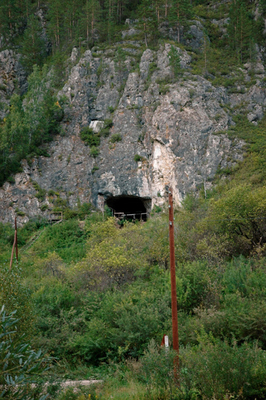
by Erin Wayman Thursday, January 5, 2012

Outside of Denisova Cave, where 'X-woman' was discovered. Bence Viola
Modern humans and Neanderthals lived side by side on the Eurasian landscape for tens of thousands of years — but it turns out they weren’t alone, much to researchers’ surprise. A team of researchers has found a hominin bone in a Siberian cave containing DNA that doesn’t match up with either known hominin species at that time, the researchers reported in Nature today, indicating that these humans shared the continent with a third, unknown hominin.
Although the mystery hominin’s identity is not yet clear, the researchers say the finding suggests that the world during the Late Pleistocene was more diverse than scientists previously thought.
“This [ancient] DNA discovery just proves again that we still have a great deal to learn about human evolution outside of Africa,” says William Jungers, a paleoanthropologist at Stony Brook University in New York, who was not involved in the research.
The bone — just the tip of a pinky finger, likely from a child due to its small size — was found in 2008 in the Denisova Cave in the Altai Mountains of southern Siberia, and dates to between 48,000 and 30,000 years ago. The researchers analyzed a complete sequence of the bone’s mitochondrial DNA — DNA inherited only through the maternal line — and then compared the bone’s mitochondrial DNA to the mitochondrial DNA of 55 modern humans and six Neanderthals. The modern humans and Neanderthals had an average of about 200 genetic differences between their DNA; the new bone had twice as many differences, suggesting that it was indeed a fossil from a separate species, the team reported.
The team dubbed the unknown hominin “X-woman.” They next determined when X-woman’s ancestors split from the ancestors of modern humans and Neanderthals. Using the molecular clock — a technique that uses the number of genetic differences between two species to determine when in the past they diverged from each other — they estimated that the split occurred approximately 1 million years ago. Modern humans and Neanderthals, by contrast, diverged closer to 500,000 years ago, according to the new research.
One million years ago is also probably when X-woman’s ancestors left Africa, said study co-author Svante Pääbo of the Max Planck Institute for Evolutionary Anthropology in Leipzig, Germany, at a press conference Tuesday to announce the finding. This date conflicts with a more traditional, “oversimplified” scenario for human evolution outside of Africa — and may be evidence that human migrations out of Africa were continual, rather than distinct events, Pääbo said.
The more traditional view has been that Homo erectus left Africa about 1.9 million years ago and subsequently populated much of Asia. Then, sometime before 500,000 years ago, Homo heidelbergensis — which some paleoanthropologists think is the common ancestor of modern humans and Neanderthals — left Africa and entered Europe, later evolving into the Neanderthals (Homo neanderthalensis). Finally, 195,000 years ago, modern humans (Homo sapiens) emerged in Africa and finally left the continent by no later than 50,000 years ago.
Whether X-woman’s DNA represents a newly discovered hominin or just a known species that has never had its DNA analyzed before is not clear. Scientists have previously only analyzed DNA from Neanderthals and modern humans. Furthermore, X-woman’s DNA came from an isolated pinky bone fragment in a cave layer containing stone tools and other artifacts. It was the only bone found in the layer, and thus not enough fossil material to use to identify a species.
But paleoanthropologists do suggest a few scenarios for the mystery hominin’s heritage.
East Asia, particularly China, has a rich hominin fossil record until about 100,000 years ago, notes Richard Klein, a paleoanthropologist at Stanford University in California. X-woman, Klein says, may be related to those hominins, which were neither modern humans nor Neanderthals, but possibly descendants of Homo erectus. Analyzing DNA from the fossils in China would be a good way to test the idea, Klein says.
But that would mean Homo erectus left Africa more than once — not only at 1.9 million years ago, but also at a later date that better matches with X-woman’s divergence from modern humans and Neanderthals 1 million years ago, said the study’s lead author Johannes Krause, also of the Max Plank Institute for Evolutionary Anthropology, at the press conference.
X-woman could also be related to Homo heidelbergensis, suggests Philip Rightmire, a paleoanthropologist at Harvard University in Cambridge, Mass. It’s possible, he says, that there was a speciation event prior to the one at roughly 500,000 years ago that led to the evolution of Neanderthals and modern humans.
Currently, the team is finishing its analysis of X-woman’s nuclear DNA — the DNA housed in cells’ nuclei, which encompasses the majority of an organism’s DNA. The findings, they say, will confirm that X-woman is neither a modern human nor a Neanderthal.
Regardless of what X-woman turns out to be, the work “shows the strength of ancient DNA,” says Brian Kemp, a molecular anthropologist at Washington State University in Pullman. “In the last couple of years, ancient DNA has seen success after success.” With just a few bones, DNA analysis allows you to unlock a wealth of information, he says. And X-woman may turn out to be the first new hominin species discovered via genetics, not fossil evidence.
© 2008-2021. All rights reserved. Any copying, redistribution or retransmission of any of the contents of this service without the expressed written permission of the American Geosciences Institute is expressly prohibited. Click here for all copyright requests.